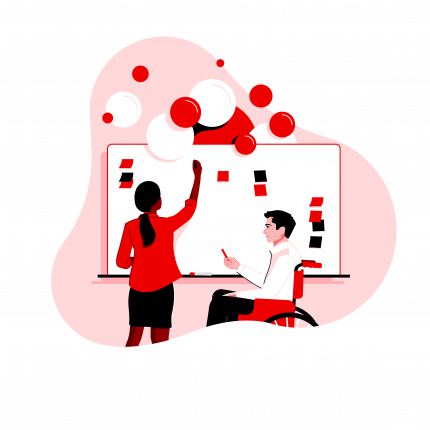Red Hat ブログ
On Red Hat’s User Experience Design (UXD) team, our connection to user experience runs deep (and not just because it’s in our name). We research, design, develop, and write together to make UX more accessible, intuitive, and inclusive across Red Hat’s product portfolio.
What can you and your team gain from focusing on these experiences too? From streamlined project plans to smoother communication, evaluating and strengthening the experiences you create brings no shortage of internal and external advantages to your team, your work, and your users. We’ll highlight some of these benefits in this post.
Experience driven? What does that mean?
Experiences drive every wireframe, code string, user test session, and line of microcopy we create — but we’re not the only ones who benefit from focusing on our users from the start. Groups across Red Hat are tapping into this approach to elevate their work — and it all starts with defining and cultivating an experience-driven mindset.
In a UXD context, this means putting our users first throughout our design process from ideation to final implementation.
“We’re starting with a user-first mindset in everything we do,” says Alan Schell, Senior Director of Red Hat User Experience Design.
In any context, experience-driven work seeks to ask and answer:
-
Who are our users and what kind of experiences do they expect?
-
What kind of experience do we currently provide compared to our users’ ideal, and what steps can we take to close that gap?
-
Where are we meeting our users in context? How will this background impact their thoughts, emotions, and expectations?
-
When will users encounter this solution? At the beginning of their workflow? The end? What kind of interactions led them here, and how can we shape this one to guide them forward in a positive and impactful way?
-
Why should users move through this experience? What are we empowering them to do?
-
How do we use what we know about our users to meet and respond to their evolving needs? How do we make unpleasant tasks more palatable in practice?
As much as being experience driven emphasizes end user experiences, it also highlights the interactions teams move through to shape them. We are what we eat — and our projects work in similar ways. Tasks completed in harmony resonate differently than those completed under duress: They can potentially lead to less errors, less friction, and less stress.
An investment in your team’s own experience is an investment in your users’ experience too. Elevating how you communicate and connect with collaborators, stakeholders, and team members translates into how you — and your product — interact with others from end to end.
Experience-driven work connects, engages, and inspires
 The value of becoming more experience driven lies in its capacity to humanize—breathing life into GitHub issues, pull requests, and other digital action items. We’re encouraged to think of our users, customers, and contributors beyond data points: They’re people. Intelligent, compassionate, invested. And the experiences we build for them, whether they’re in a product or social context, should be too.
The value of becoming more experience driven lies in its capacity to humanize—breathing life into GitHub issues, pull requests, and other digital action items. We’re encouraged to think of our users, customers, and contributors beyond data points: They’re people. Intelligent, compassionate, invested. And the experiences we build for them, whether they’re in a product or social context, should be too.
When we use experiences as a guide, our team goals are driven by more than just quantitative measures and metrics. We think more critically about the interactions we support in-product, cross-team, and cross-community. Experience-driven work merges function and fellowship: It drives us to shape end-to-end experiences that connect, engage, and inspire.
Key benefits of an experience-driven mindset
Experience-driven work is user-first, people-first, and experience-first: three qualities that hinge on understanding and connecting with others.
No matter your team or context, those who adopt an experience-driven approach enjoy several key gains:
-
An open forum for communication and collaboration surrounding key decisions and their impact.
-
A consistent understanding of user needs that leads to more agile and effective solutions.
-
A workflow that evolves with, responds to, and supports your user base.
-
A community of users and contributors that know you value and respect them.
So now we know what an experience-driven mindset is and how it works. How can we start actually using it? If you collaborate with others, experiences are already embedded in your work. Kickstarting a consciously experience-driven mindset involves amplifying how you view, interpret, and shape them.
Let’s explore how teams are putting experience-driven mindsets to practice to strengthen their connections with their users — and each other.
How Red Hat teams are putting the mindset in action
Various people in and outside of Red Hat help build connections between our users and products through user research, customer interactions, hands-on workshops, and more. We recognize that the user experience extends beyond just one touch point, so many of us try to consider our contributions holistically.
“Understanding and being cognizant of how each part of the journey impacts another is foundational to being customer and experience driven,” says Nick Woerner, Senior Manager of Voice of Customer at Red Hat.
With that said, there might not be a single data point or metric you look at to determine success. “When you do a user experience right,” says Mike McGrath, Vice President of Linux Engineering, “People won’t be sure you’ve done anything at all.”
Successful experiences are exactly what McGrath describes: Seamless. Natural. Intuitive. They stem from keeping your finger on the pulse of user needs, goals, and pain points to meet them where they are with the tools, information, and functionality they need to get the job done.
Experience-driven work, the open source way
Open source relies on community collaboration, and these communities often create through shared experiences. So think forward. Embrace empathy. Consider the actions you take and the ripple effects they’ll have long after.
Center experiences at the heart of your work — your users, customers, teammates, and community members just might thank you.
Red Hat UXD is on a constant mission to elevate Red Hat products, the open source way — and for that, we need you. Join our research community to tell your story, share feedback, and help shape future Red Hat experiences.
執筆者紹介
Alana Fialkoff is a storyteller with a B.A. in English Literature and an M.O. in all things language. Across user interfaces and social channels, she uses her voice (and empowers others) to create streamlined content experiences that are more accessible, immersive, and human.

